Life on the Rigs
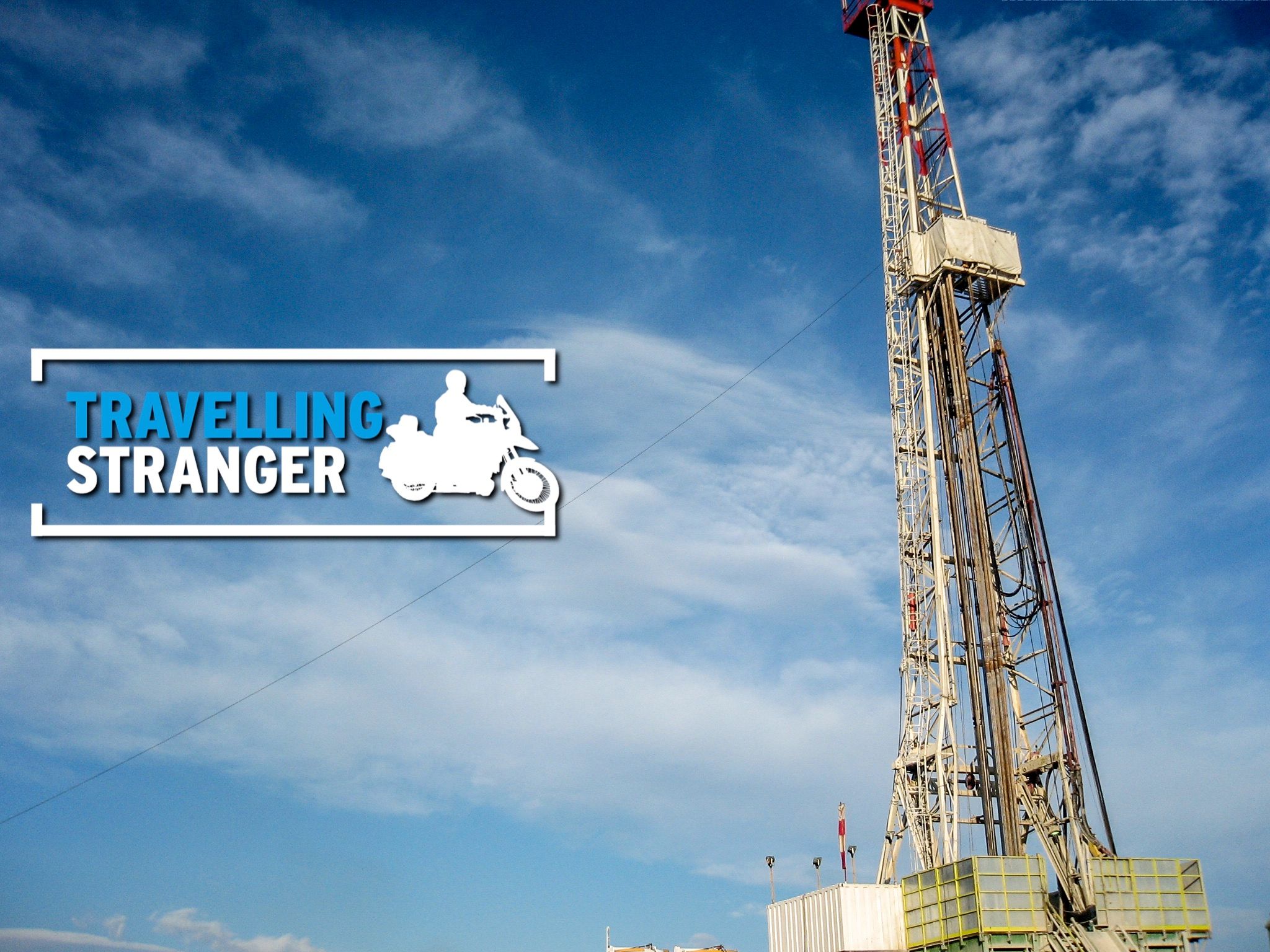
All pics by author
Hello my Steeming Pals!
Italiano
Per alcuni anni in passato ho lavorato per l’industria estrattiva ed in particolare per il settore degli idrocarburi, i cosiddetti combustibili fossili: petrolio e gas. Ciò a suo tempo comportò assenze da casa per soggiorni lunghi, talvolta mesi presso cantieri locati in luoghi spesso insoliti.
Dalle “offshore installations” in mezzo al Mare del Nord alle spiagge del Borneo, alle foreste della Bolivia, se v’era una trivella (detta “rig”) in affari con la mia ditta, ci venni spedito per partecipare ai lavori di terebrazione.
Era un lavoro che molti considerarono insolito e che ancora oggi desta curiosità.
“Com’è la vita sui rig ?” mi sento sovente domandare.
“È un pò come vivere in caserma” rispondo, “…senza però l’obbligo dell’adunata per l’alza bandiera”.
Mi alzavo sempre presto alla mattina per prepararmi per il turno di 12 ore. Tutti i lavoratori del turno "di giorno" erano in piedi già verso le quattro per procedere con calma ai preparativi della giornata. Una doccia, qualche lettura, una controllata alla posta elettronica, magari un pò di attività fisica in palestra (se ve n'era una).
Poi, la colazione: uova, bacon, salsicce, funghi, pomodori, toast con caffè.
Ma il tempo era poco per perdersi in chiacchiere ai tavoli. Prima delle sei occorreva muoversi verso gli spogliatoi, indossare scarponi, la tuta, il casco, i tappi per le orecchie ed uscire in mezzo al trambusto dei macchinari per dare il cambio al collega del turno della notte.
English
For several years I worked on the rigs, for the oil and gas industry around the globe. For weeks, sometimes months at a time I was dispatched away from home, sent by my employer to wherever drilling operations might be under way. Sometimes I joined operations in the middle of the North Sea, other times it was on the coast of Borneo or in the forests of Bolivia.
It was (and still is) considered an unconventional career, the type of job that raises curiosity to say the least.
“What’s life on a rig like?” I have often been asked.
“It depends” I usually answer, “ it’s usually not much fun, perhaps not too different from living in army barracks, but without all the stern discipline.”
Days on a rig can seem pretty monotonous. They start very early when you’re on “day shift”, maybe three or four am, early enough to enjoy a shower, read a few pages of a book, catch up with some e-mails perhaps or indulge in the gym for a short while (if there's a gym available on the right all). The rig galley would open at around 5am for breakfast. This was often the most enjoyable meal of the day with a rich variety of morning food to choose from: eggs, bacon, mushrooms, sausages, tomatoes along with and toast and cereal.
There was little time for conversation at the breakfast table though and the last gulp of coffee was invariably on cue with a move to the changing rooms. Coveralls, safety boots, specs, hard hat and you were out, on the rig sight before six am for the all important handover with your colleague at the tail end of his night shift.
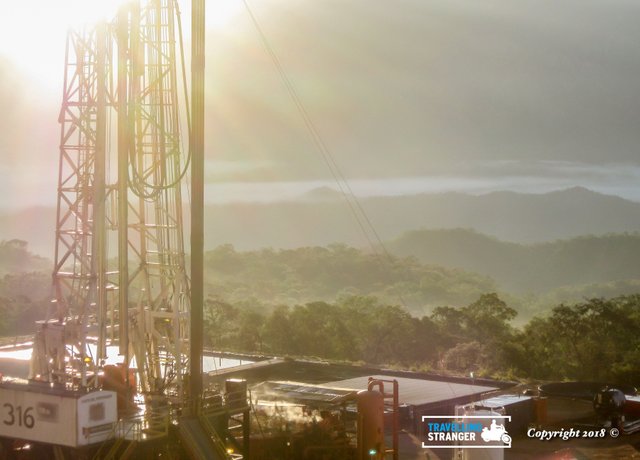
Early morning sun clears the mist over the forest in Bolivia
D’inverno sui rig nel Mare del Nord v’era sempre buio, il vento soffiava forte e le piattaforme ondeggiavano vistosamente. Occorreva mantenere una presa salda sulle ringhiere delle passerelle all'aperto e prestare attenzione alle raffiche di vento capaci di sbilanciare anche l’uomo più robusto.
In Asia ed in Africa invece era sempre estate ma il caldo e l’umido potevano essere ugualmente molesti. Occorreva rimanere idratati e fare attenzione ai raggi del sole.
Il lavoro sui rig poteva svolgersi a ritmi molto diversi. Durante il corso di alcuni turni s’era occupatissimi con giornate piene di responsabilità con poco tempo per pause e caffè mentre in altri turni le cose proseguirono con calma, senza frenesia. Mi ricordo che spesso l’avanzamento dei lavori di perforazione dipese dalle capacità di un singolo, un professionista esperto, dalle sue competenze, dalle sue intuizioni e dalla sua esperienza. Era il caso dei i driller, e dei tool pusher. Altre volte il tutto roteava attorno dall’affiatamento di una squadra di quattro oppure cinque ragazzotti impegnati a manovrare macchine, gru, tubi e cavi.
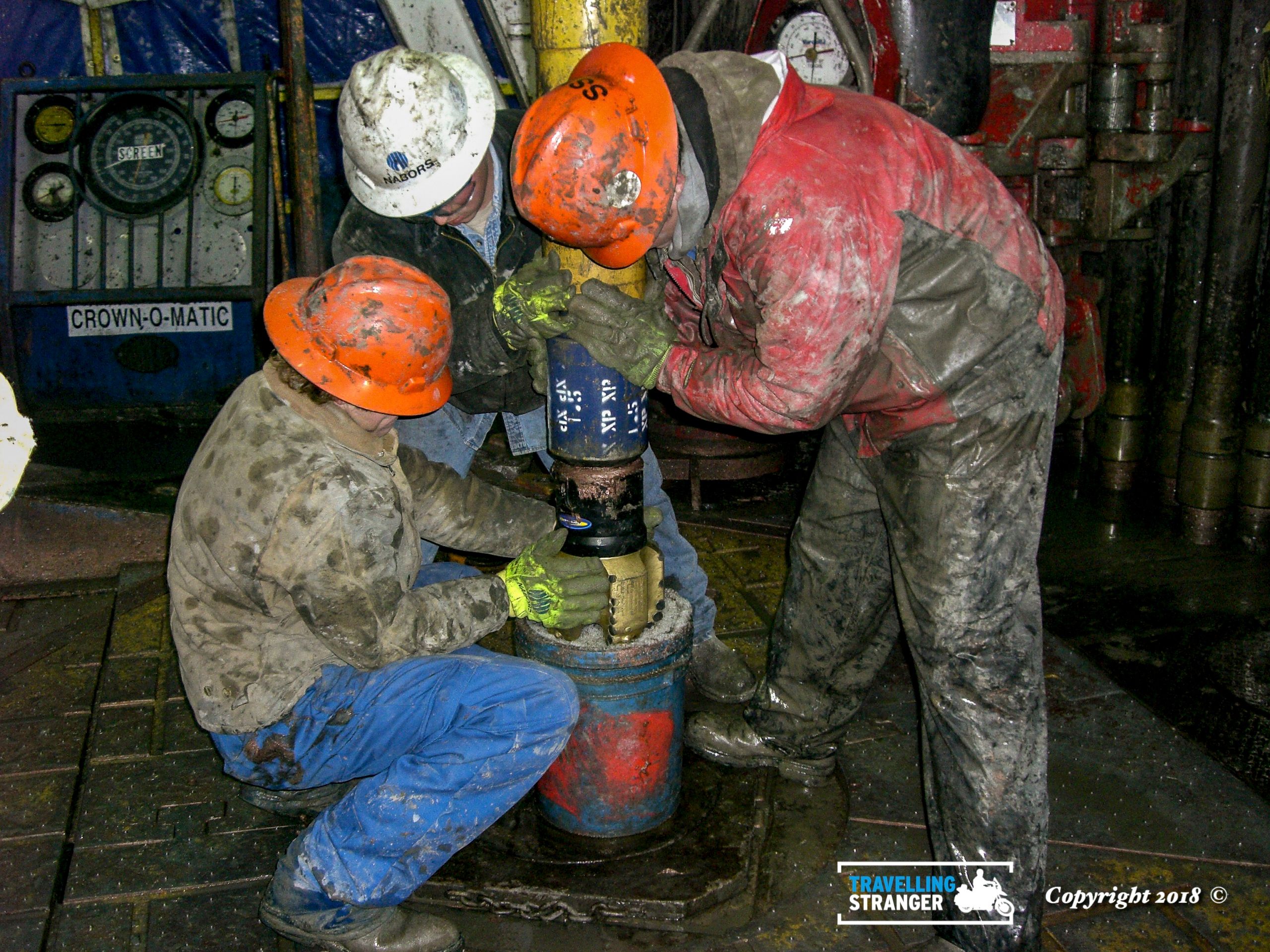
Roughnecks checking a drill bit
Naturalmente vi furono guasti di vario genere quasi ogni giorno sul rig : rotture elettriche, meccaniche, problemi di perforazione (“kick”) ed in questi casi tutto si fermava per effettuare le riparazioni necessarie. Tra i motivi più bizzarri per interrompere i lavori rammento: tempeste solari, perdita di macchinari in mare, il passaggio di mammiferi marini vicino al rig (branchi di balene e delfini).
È inutile negare che l’ambiente della piattaforma era ed è tuttora prettamente maschili ma a volte ciò non corrisponde sempre al vero. In Norvegia constatai che una buona parte della forza lavoro sui rig era composta da donne che ricoprono pure ruoli in cui occorreva una particolare tenacia fisica.
Ex carcerati, laureati, ex militari ricordo che v’era un po di tutto sui rig. Anche le nazionalità erano molto varie e soprattutto sui cantieri inglesi il mix di lavoratori provenienti da ogni parte d' Europa era straordinario: un bel modello d’integrazione.
Il ruolo forse più ingrato sul cantiere era, a mio avviso, quello ricoperto dal cuoco. Se il cibo in mensa era passabile, il morale dei riggers rimaneva alto ma se ad ogni pasto veniva rifilata sbobba nauseante (capitava) o cibo in scatola riscaldato, le lamentele non tardarono mai ed ecco che il cuoco era subito bersaglio di scherzi, cattiverie ed ingiurie.
The winter months in the North Sea were always dark with almost no sun light all day, often with severe weather conditions as well: strong winds and white seas. Floating semisubmersible rigs would heave noticeably in the rough weather and you had to keep a good grip on railings whilst out in the open so as not to get caught out by the stronger gusts rushing though the gaps of the rig structure.
In Africa and Asia, on the contrary, the weather was always warm and sunny, however this held hazards of it’s own with dehydration issues to be aware of and the stinging rays from the sun to protect yourself from.
Work could be frantic at times with days of quick paced drilling and responsibilities to heed to. Of course there were days of calm with not much happening at all as well. Not everyone on the rig was aware of what was actually happening from the drilling perspective. All however, played their part regardless. At times operations depended on the experience and judgement of a single seasoned professional (drillers, tool pushers) at other times operations were in the hands of teams of roughnecks, crane operators or casing crews working together like a clockwork.
There were mechanical and electrical as well as geological issues that would regularly halt operations and needed to be addressed every day. Sometimes though operations were momentarily stopped for reasons that might seem bizarre such as: solar activity, drilling tools dropped at sea, marine mammals in the vicinity of the offshore installation.
Rigs were and still are predominantly male environments however there are exceptions to this rule. On the few trips I made to Norway it became clear to me that a good part of the off shore personnel there was made up of women, some of whom had physically demanding tasks, too.
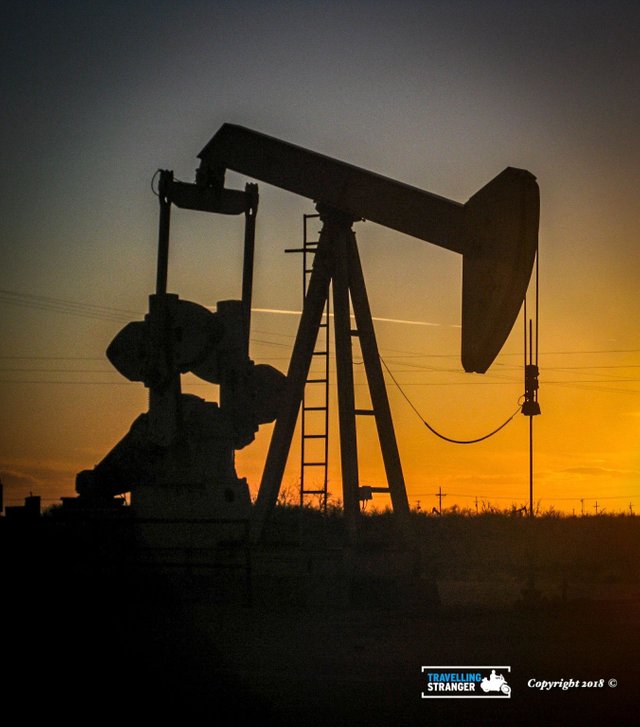
A Nodding Donkey Oil Pump, an iconic land mark in New Mexico, USA
There were people from all walks of life on the rigs: ex convicts, ex military, ex business owners, high school and university graduates. Nationalities amongst individuals varied greatly as well and on British installations the crews were often made up of workers from all over Europe. A real model of integration some might say.
Perhaps the most ungrateful job on a rig was that of camp boss (chef). As long as the food served in the rig galley was acceptable, morale amongst the workforce remained high.
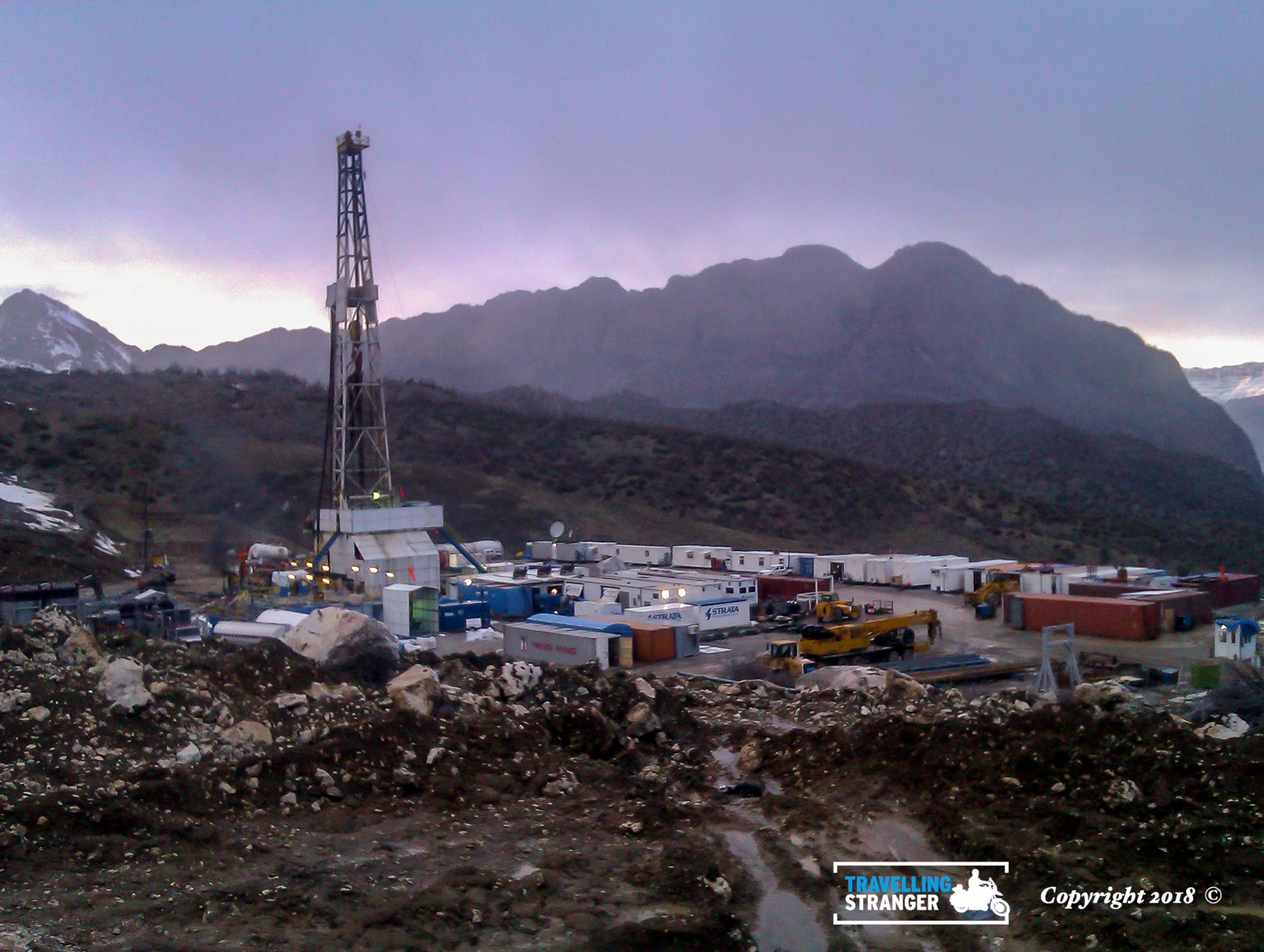
Drilling in Kurdistan, Iraq
In alcune occasioni mi dovetti adattare a situazioni considerate ad “alto rischio” per la possibilità di fughe di gas tossici dal sottosuolo, il solfuro di idrogeno (H2S) in primis. In questi casi v’era sempre l’obbligo di avere un respiratore con bombola d’aria pura a portata di mano pronto all’utilizzo in caso di un’emergenza. Una bella zavorra da portarsi sempre appresso, perfino in bagno.
Ai rig in mezzo al mare si arrivava tramite elicottero oppure in barca se le condizioni del mare lo permettevano. Talvolta i voli duravano ore. Credetemi: gli elicotteri sono scomodi, stretti e rumorosi. Non mi piacciono.
I primi giorni su di un cantiere non erano mai piacevoli. Si era pieni di malinconia, soprattutto attorno alle feste di fine anno. Tuttavia ci si lasciava presto prendere dalla routine, dal lavoro e senza accorgersene le giornate passarono. Le giornate si tramutarono in settimane e queste talvolta in mesi.
Le trivelle non si fermavano mai, lavoravano 24 ore al giorno per sette giorni alla settimana. Non v’era weekend, non v’erano feste comandate. Si perforava di continuo per trovare nove risorse da sfruttare.
Inevitabilmente il giorno agognato del ritorno a casa arrivava sempre puntuale. Ecco allora che preparavo la mia borsa con un sorriso stampato in faccia. Al rientro a casa mi aspettavano giorni di riposo, senza stress, da godere in relax in attesa dell'impegno lavorativo successivo.
A pensarci bene, credo che fu soprattutto in quei giorni, quelli del rientro dal cantiere che mi parve sempre di avere il miglior lavoro del mondo!
However, if the crew became unsatisfied with the menu, then the cook was inevitably the object of fierce scorn and disrespect.
I sometimes worked in conditions labelled as hazardous such as geological environments that contained the threat of of hydrogen sulphide (H2S) gas. In these instances all personnel were issued with a breathing apparatus to be carried around like a handbag, ready for use in the case of an emergency. The bag was annoying. It had to be carried everywhere, even to the facilities.
Rigs in the middle of the sea were reached via helicopter or by boat if the sea conditions were calm enough. Sometimes helicopter flights were long with refuelling stops involved. Believe me, helicopters are cramped, uncomfortable noisy things. I don't like them.
The first days on a new work sight were never really enjoyable. But inevitably one would fall into into a routine soon enough. Slowly the days would go by. The days would become weeks and sometimes the weeks would turn into months. Drilling operations were incessant 24hours a day for 7 days a week. There no weekends, no Christmas, no new year’s day.
Of course the last day on location would always come, time to go home. Workers on their way home always had a smug smile on their face. Work was done, it was time to get back to the real world for days of rest (weeks) before the call for the next job arrived. A great feeling!
Come to think of it it was mostly on those days, the ones where I was on my way home form the rig after weeks on a a job that I would tell myself that I had the best job in the world!
Che lavoro avventuroso! Mi ero sempre chiesta come fosse la vita nei rigs ;)
Forte! Partiamo?!|
Grande @john-gpr complimenti bel blog